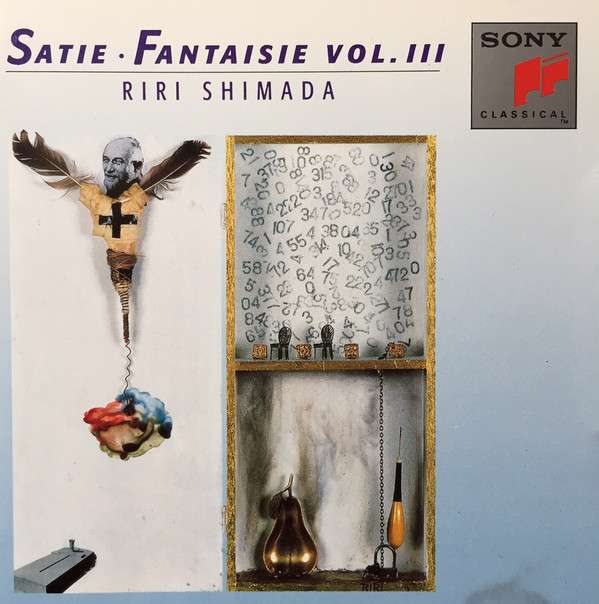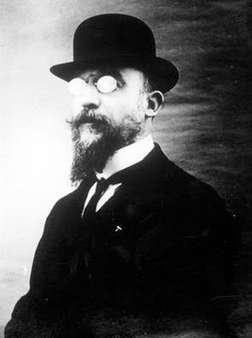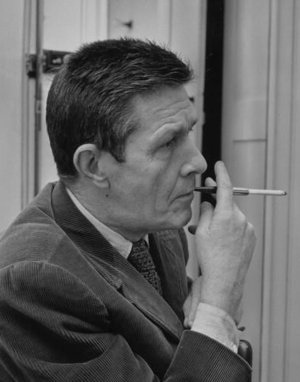
Erik Satie, Riri Shimada
Satie Fantaisie Vol. III
Compil. JP 1993 on Sony Classical label
Classical (Modern)
Tracks 1 to 14 recorded at Ishibashi Memorial Hall, October 10th 1987. Track 15 recorded at Fukushima Hall, July 1st 1987. 1917 "ballet réaliste" Parade's subject matter has been described by Jean Cocteau as follows: "The scenery represents the houses of Paris one Sunday. Fairground booth. Three music-hall numbers serve as an introduction to the entretainment inside: Chinese Conjuror, Acrobats, Little American Girl. Three Circus Barkers drum up trade. They communicate in their terrible language so that the crowd mistakes their comic turn for the real show inside, a mistake which they try in their borrish way to disabuse them of. No one enters. After the final number of the parade, the exhausted Barkers collapse in a heap. The Chinaman, the Acrobats and the Little Girl emerge from the empty theatre. Seeing the supreme effort and collapse of the Barkers, they try in their own turn to explain that the real show takes place inside. N.B. The management reserves the right to change the order of the numbers in the parade." Inspired by his concern for ostinato repetition, Musique d'Ameublement and Vexations illustrate Satie's anticipation of minimalism. It is worth noticing that an important number of the original manuscripts for these piece of work nowadays belong to John Cage hismelf. Presented here in a shortened 13 minutes long version, Vexations consists in a single theme, followed by two harmonizations meant to be played 840 times repeatedly. Satie wrote that: "before palying this motif, it would be advisable to prepare oneself well in advance, in the most profound silence, by observing a period of serious immobility". John cage is in fact the only musician who has organized a complete 24 hours long performance of it in 1963.
Musicians
 | Erik Satie bvoc, 1866-1925 FR album by |
 | Riri Shimada p, piano, album by |
 | Hiroshi Yamaguchi voc, arranged by |
 | John Cage voc, 1912-1992 US arranged by |
 | Noriko Tokuoka piano |
Producers
| Ken-Ichi Handa engineer |
| Tetsuo Baba engineer |
| Kenji Hata photography |
| Toshiki Muto producer |
Composers
| Erik Satie |
Album Tracks
| No | Title | Artist | Composer | Duration |
|---|---|---|---|---|
| 1 | Socrate (1918) | Erik Satie, Riri Shimada | ||
| 2 | I: Portrait De Socrate (Le Banquet) | Erik Satie, Riri Shimada | 6:11 | |
| 3 | II: Bords De L'Ilissus (Phèdre) | Erik Satie, Riri Shimada | 7:22 | |
| 4 | III: Mort De Socrate (Phédon) | Erik Satie, Riri Shimada | 14:49 | |
| 5 | Parade (1917) | Erik Satie, Riri Shimada | ||
| 6 | I: Choral | Erik Satie, Riri Shimada | 0:46 | |
| 7 | II: Prélude Du Rideau Rouge | Erik Satie, Riri Shimada | 1:40 | |
| 8 | III: N° 1: Prestidigitateur Chinois | Erik Satie, Riri Shimada | 2:26 | |
| 9 | IV: N° 3: Petite Fille Américaine | Erik Satie, Riri Shimada | 1:28 | |
| 10 | V: Rag-time Du Paquebot | Erik Satie, Riri Shimada | 2:11 | |
| 11 | VI: N° 2: Acrobates | Erik Satie, Riri Shimada | 3:36 | |
| 12 | VII: Final | Erik Satie, Riri Shimada | 1:54 | |
| 13 | VIII: Suite Au Prélude Du Rideau Rouge | Erik Satie, Riri Shimada | 0:24 | |
| 14 | Musique D'Ameublement (1923) | Erik Satie, Riri Shimada | ||
| 15 | I: Tenture De Cabinet Préfectoral | Erik Satie, Riri Shimada | 3:07 | |
| 16 | II: Tapisserie En Fer Forgé | Erik Satie, Riri Shimada | 1:26 | |
| 17 | III: Carrelage Phonique | Erik Satie, Riri Shimada | 0:52 | |
| 18 | Vexations (1893) | Erik Satie, Riri Shimada | 12:50 |
